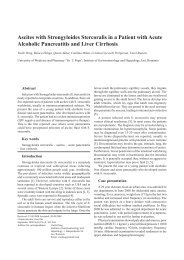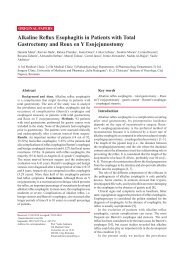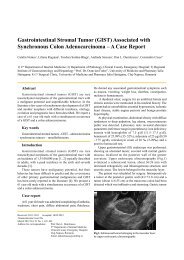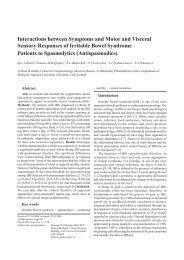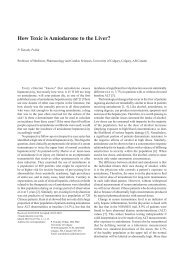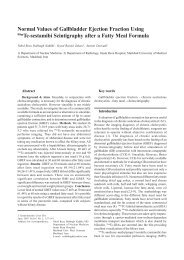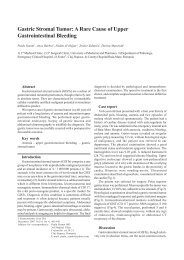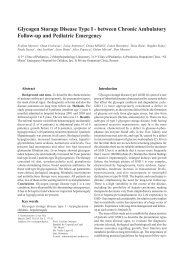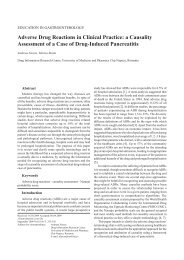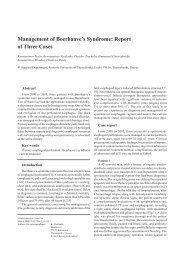Amiodarone Induced Liver Cirrhosis. Report of two cases
Amiodarone Induced Liver Cirrhosis. Report of two cases
Amiodarone Induced Liver Cirrhosis. Report of two cases
You also want an ePaper? Increase the reach of your titles
YUMPU automatically turns print PDFs into web optimized ePapers that Google loves.
234 Atiq et al<br />
was no history <strong>of</strong> alcohol use. Review <strong>of</strong> her medications<br />
revealed she was on low dose amiodarone which she had<br />
been taking for 2 years around the time <strong>of</strong> AICD placement.<br />
On examination, her vital signs were stable. Examiantion<br />
revealed asterixis, mild right upper quadrant tenderness<br />
and trace ascites. Her initial work up at the outside hospital<br />
revealed serum aspartate amino transaminase 377 IU/L,<br />
alanine amino transaminase 277 IU/L, alkaline phosphatase<br />
551IU/L, prothrombin time <strong>of</strong> 12.7 seconds. Serologic studies<br />
were negative for chronic viral hepatitis, and there was no<br />
clinical or laboratory evidence for autoimmune hepatitis,<br />
Wilson’s disease, or hemochromatosis. Ultrasound <strong>of</strong> the<br />
liver with Doppler showed homogeneous liver parenchyma<br />
and mild ascites. Sections <strong>of</strong> liver biopsy showed a<br />
marked neutrophilic infiltrate with associated degenerating<br />
hepatocytes and a remarkable amount <strong>of</strong> Mallory hyaline<br />
with well developed pericellular fibrosis and bridging fibrosis<br />
with evidence <strong>of</strong> early cirrhosis, consistent with amiodarone<br />
toxicity (Fig. 2). The patient developed cardiopulmonary<br />
failure during her hospital stay and subsequently died.<br />
Discussion<br />
Fig 2. Medium-power view <strong>of</strong> amiodarone toxicity<br />
showing hepatocytes with Mallory hyaline surrounded<br />
by neutrophils. H&E; original magnification x200.<br />
<strong>Amiodarone</strong> is lipophilic and thus accumulates in lipidladen<br />
organs such as the liver. This accumulation in the<br />
lysosomes <strong>of</strong> hepatocytes, as well as bile duct epithelium<br />
and Kupffer cells leads to a build up <strong>of</strong> phospholipids which<br />
produces a phospholipidosis on the basis <strong>of</strong> inhibiting<br />
phospholipase A1 and A2 [7, 8]. Whether phospholipidosis<br />
causes hepatocellular injury is uncertain as liver disease<br />
occurs in only 1% to 3% <strong>of</strong> recipients <strong>of</strong> amiodarone, while<br />
a much larger percentage <strong>of</strong> patients treated with amiodarone<br />
develop phospholipidosis. Therefore, liver injury might<br />
occur separate from or in conjunction with phospholipidosis,<br />
explaining why cirrhosis rarely occurs in patients treated<br />
with amiodarone [1, 2, 6, 9].<br />
Due to its amphophilic nature, amiodarone and its principal<br />
metabolite, N-desethylamiodarone, have been detected in<br />
serum months after stopping the drug [1, 5]. Because the<br />
drug is released slowly from deposits in lysosomes, hepatic<br />
abnormalities may persist for one year even after the drug is<br />
discontinued [1]. Continued liver damage during treatment<br />
with amiodarone may also be secondary to the fact that<br />
amiodarone causes hepatic dysfunction initially and further<br />
limits the hepatic metabolism, thus further increasing the<br />
serum concentration [10]. Consequently, some investigators<br />
have speculated that the total cumulative dose might be<br />
more important in estimating the risk <strong>of</strong> irreversible liver<br />
injury [11].<br />
It is well known that steatosis and non-alcoholic<br />
steatohepatitis (NASH) can be induced by several drugs,<br />
including tamoxifen and anti-retroviral agents [12]. These<br />
drugs inhibit the mitochondrial β-oxidation <strong>of</strong> fatty acids<br />
and respiration, with resultant decrease in ATP and increased<br />
mitochondrial formation <strong>of</strong> reactive oxygen species. These<br />
reactive oxygen species along with lipid peroxidation<br />
products may cause mitochondrial dysfunction which can<br />
also lead to apoptosis and necrosis, thus activating a cascade<br />
leading to fibrosis [13]. Also, many patients receiving<br />
amiodarone have underlying diabetes and hyperlipidemia<br />
such as our first case and a background <strong>of</strong> non alcoholic<br />
fatty liver disease cannot be ruled out; however, rapid<br />
deterioration after instituting amiodarone certainly renders<br />
amiodarone usage the most likely causative agent <strong>of</strong> rapid<br />
liver decompensation secondary to cirrhosis. Also, the<br />
biopsies were not very suggestive <strong>of</strong> steatohepatitis and<br />
in fact showed Mallory hyaline which is very typical <strong>of</strong><br />
amiodarone toxicity.<br />
To date, a total 8 <strong>cases</strong> <strong>of</strong> amiodarone induced cirrhosis<br />
have been reported in the literature [2, 4, 6, 14-19]. As<br />
evident from our <strong>cases</strong>, the range <strong>of</strong> amiodarone usage for<br />
these <strong>two</strong> <strong>cases</strong> was between 2 and 3 years. Our inability<br />
to accurately assess when the first effects <strong>of</strong> amiodarone<br />
induced hepatotoxicity occurred, makes a pharmacokinetic<br />
explanation alone less prudent. A clinical association with<br />
initiation <strong>of</strong> therapy as well as histological features suggestive<br />
<strong>of</strong> amiodarone toxicity strengthens the possibility <strong>of</strong> a causal<br />
relationship. Hence, these <strong>cases</strong> illustrate the importance <strong>of</strong><br />
checking baseline liver associated enzymes in patients who<br />
are being considered for amiodarone therapy, as well as<br />
monitoring them closely during therapy even with low dose<br />
amiodarone. Also, strict alcohol cessation must be ensured<br />
before the beginning <strong>of</strong> therapy due to amiodarone effects<br />
in causing a pseudo-alcohol like syndrome. It is unclear in<br />
the light <strong>of</strong> present data if amiodarone induced cirrhosis may<br />
occur without any abnormalities in liver associated enzymes.<br />
It has been suggested that concentrations <strong>of</strong> amiodarone<br />
below a threshold <strong>of</strong> 1.5 mg/L are associated with a minimal<br />
risk <strong>of</strong> hepatotoxicity, whereas concentrations greater than<br />
2.5 mg/L are associated with a greater than 6% risk <strong>of</strong><br />
hepatotoxicity. There is significant discordance between<br />
changes in amiodarone concentration and the resulting<br />
change in ALT. This model suggests that monitoring ALT<br />
at baseline, 1, 3, and 6 months, and then semiannually<br />
would be an efficient strategy to detect amiodarone-induced<br />
hepatotoxicity [20]. Therefore, it would be premature to<br />
make suggestions about the necessity <strong>of</strong> routine imaging or<br />
biopsy in these patients.




